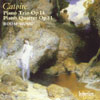Catoire Piano Trios
If you like the Russian Impressionists, try these engaging chamber works
View record and artist detailsRecord and Artist Details
Composer or Director: Georgy L'vovich Catoire
Genre:
Chamber
Label: Hyperion
Magazine Review Date: 4/2005
Media Format: CD or Download
Media Runtime: 55
Mastering:
Stereo
DDD
Catalogue Number: CDA67512

Tracks:
| Composition | Artist Credit |
|---|---|
| Elegy |
Georgy L'vovich Catoire, Composer
Georgy L'vovich Catoire, Composer Room-Music |
| Piano Trio |
Georgy L'vovich Catoire, Composer
Georgy L'vovich Catoire, Composer Room-Music |
| Piano Quartet |
Georgy L'vovich Catoire, Composer
Georgy L'vovich Catoire, Composer Room-Music |
Author: kYlzrO1BaC7A
Georgy Catoire’s name is little known outside Russia, though he became a much-respected teacher of, among others, Kabalevsky. He was born in Moscow in 1861, the son of an assimilated French family, and only after a false start as a mathematician in his father’s firm did he give himself to his real love, music. He then studied with Wagner’s disciple Karl Klindworth, also attracting the respect and encouragement of Tchaikovsky.
It is a duality which shows in the first of the two chamber works recorded here. The Piano Trio of 1900 sets off with an obvious awareness of Tchaikovsky’s Trio, but soon strays into German territory with rich textures and virtuoso keyboard writing that, rather than Wagner, suggest Brahms or still more Schumann at their most profuse. Catoire’s own character emerges more distinctively in the Allegretto fantastico, a deft, engaging piece of work with some surprising harmonic and rhythmic adventurousness.
With the Piano Quartet of 1916, Catoire’s admiration for Scriabin is evident, and to the German and Russian influences is added a sense of his French roots: he must surely have known and been impressed by Debussy. It is the harmonic manner which suggests Debussy, not the textures: the piece is again rather overwritten, but, like the more slender violin-and-piano Elegy, it has a harmonic delicacy that rewards repeated hearings.
This is music which could certainly appeal to those who are attracted by Russian Impressionism, or by Scriabin’s piano works, especially in these performances. They are led by Stephen Coombs, author of an informative insert-note, who is undaunted by the intricacies which Catoire wishes upon his pianist.
It is a duality which shows in the first of the two chamber works recorded here. The Piano Trio of 1900 sets off with an obvious awareness of Tchaikovsky’s Trio, but soon strays into German territory with rich textures and virtuoso keyboard writing that, rather than Wagner, suggest Brahms or still more Schumann at their most profuse. Catoire’s own character emerges more distinctively in the Allegretto fantastico, a deft, engaging piece of work with some surprising harmonic and rhythmic adventurousness.
With the Piano Quartet of 1916, Catoire’s admiration for Scriabin is evident, and to the German and Russian influences is added a sense of his French roots: he must surely have known and been impressed by Debussy. It is the harmonic manner which suggests Debussy, not the textures: the piece is again rather overwritten, but, like the more slender violin-and-piano Elegy, it has a harmonic delicacy that rewards repeated hearings.
This is music which could certainly appeal to those who are attracted by Russian Impressionism, or by Scriabin’s piano works, especially in these performances. They are led by Stephen Coombs, author of an informative insert-note, who is undaunted by the intricacies which Catoire wishes upon his pianist.
Discover the world's largest classical music catalogue with Presto Music.

Gramophone Digital Club
- Digital Edition
- Digital Archive
- Reviews Database
- Full website access
From £8.75 / month
Subscribe
Gramophone Full Club
- Print Edition
- Digital Edition
- Digital Archive
- Reviews Database
- Full website access
From £11.00 / month
Subscribe
If you are a library, university or other organisation that would be interested in an institutional subscription to Gramophone please click here for further information.




